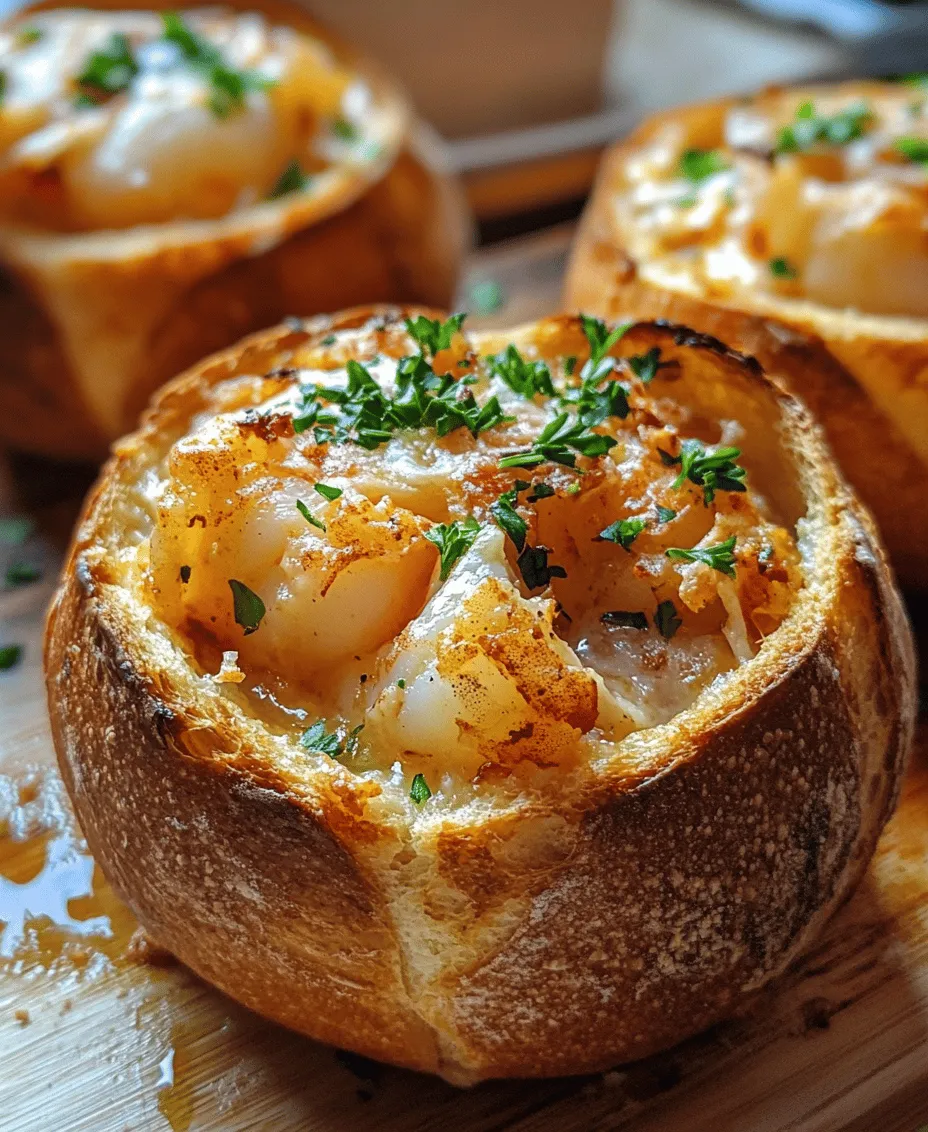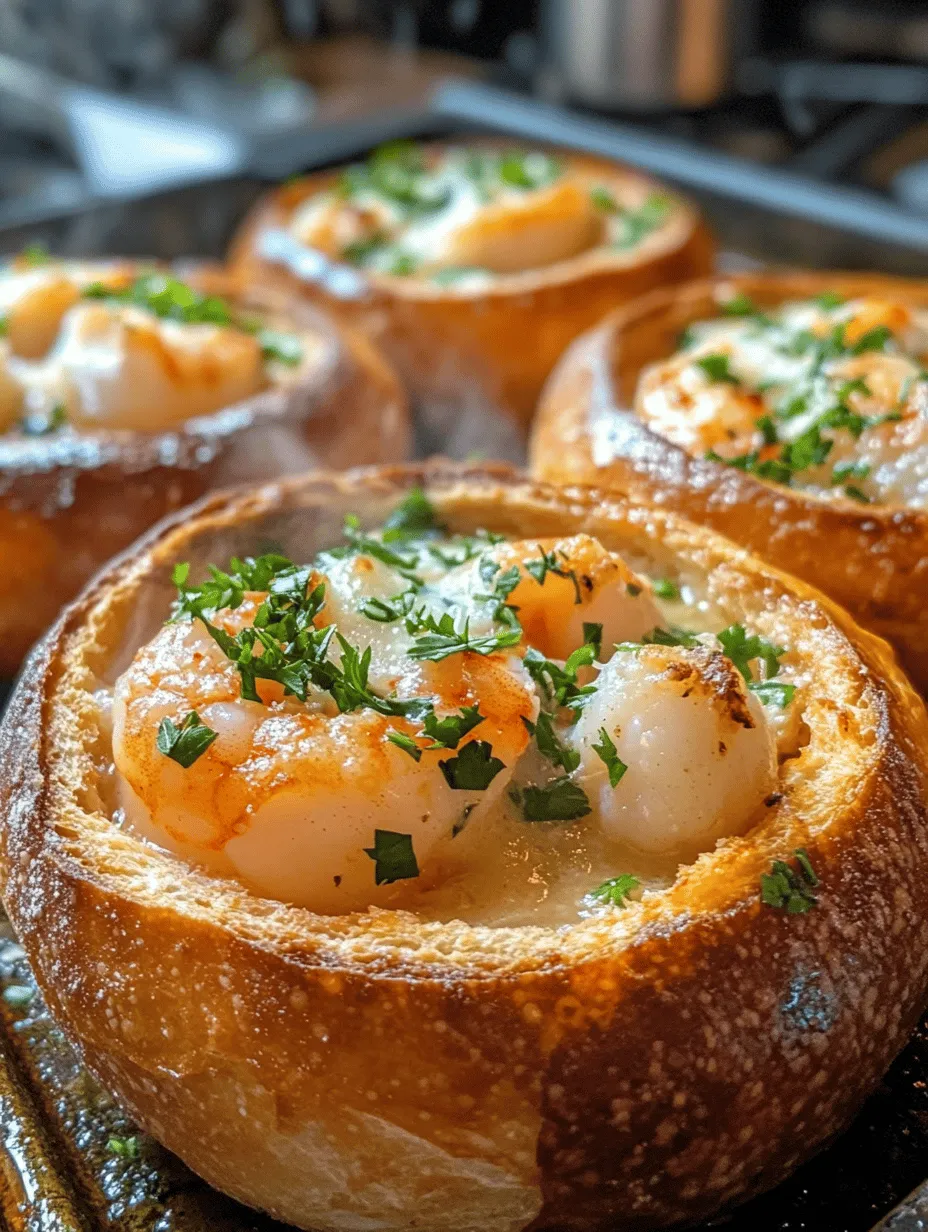Introduction
Imagine a chilly evening, where the comforting aroma of a warm, savory soup fills your kitchen. Now, picture that soup served in a freshly baked bread bowl, perfectly capturing the essence of comfort food. This is exactly what the Stuffed Seafood Soup Bread Bowl embodies—a delightful fusion of rich flavors, hearty textures, and culinary creativity that elevates a simple soup to a satisfying meal.
The beauty of combining seafood and bread in a comforting soup lies in its ability to create a dish that is not only delicious but also visually appealing. Each bite brings together the tender, succulent seafood nestled within a creamy, flavorful broth, all encased in a crusty, warm bread bowl. This recipe showcases the perfect balance of flavors, from the brininess of the ocean-fresh seafood to the warm, toasted notes of the sourdough bread.
Beyond its exquisite taste, the stuffed seafood soup bread bowl has a rich cultural significance. Bread bowls have been a staple in various cuisines around the world, from clam chowder in New England to goulash in Eastern Europe. They embody the idea of resourcefulness in cooking—transforming leftover bread into a vessel for hearty soups and stews. This recipe not only pays homage to this tradition but also adds a modern twist by featuring a medley of seafood that makes it truly special.
Understanding the Ingredients
To create a stuffed seafood soup bread bowl that delights the senses, it is essential to understand the key ingredients and their roles in the recipe. Each component contributes to the overall flavor profile and texture, ensuring that every bite is a harmonious blend of deliciousness.
Fresh Seafood
The star of this dish is undoubtedly the seafood. Fresh shrimp, scallops, and crab meat each bring their unique flavors and textures to the mix. Shrimp adds a sweet and slightly briny taste, while scallops contribute a delicate, buttery richness. Crab meat, with its sweet and succulent profile, elevates the dish further, creating a symphony of flavors that transport you straight to the coast. The importance of using fresh seafood cannot be overstated; it significantly impacts the soup’s taste and overall quality.
Sourdough Bread
Next, we have the bread itself—sourdough. Known for its tangy flavor and chewy texture, sourdough is the perfect choice for this recipe. Its robust crust holds up well against the soup, preventing it from becoming soggy too quickly, while the soft interior absorbs the rich broth. As the soup melds with the bread, it creates a delightful combination that keeps you coming back for more.
Aromatics
Aromatics such as onions and garlic play a crucial role in building flavor in any soup. Sautéing these ingredients releases their natural sweetness and enhances the overall taste of the dish. The aromatic base sets the stage for the seafood and broth, creating a depth of flavor that is both comforting and inviting.
Heavy Cream and Seafood Stock
For richness, heavy cream and seafood stock are indispensable. The cream adds a velvety texture and a touch of indulgence to the soup, while the seafood stock serves as a flavorful foundation, amplifying the ocean-inspired essence of the dish. This combination ensures that each spoonful is a luxurious experience, enveloping your palate in warmth.
Seasonings
Finally, the seasonings are key to achieving the perfect balance of flavors. A blend of Old Bay seasoning, paprika, and cayenne pepper provides a delightful kick, enhancing the natural flavors of the seafood without overwhelming them. The Old Bay seasoning, with its blend of herbs and spices, offers a nod to classic seafood dishes, making it an essential component in this recipe.
Preparation Steps Explained
Now that we have a clear understanding of the essential ingredients, let’s delve into the preparation process of the Stuffed Seafood Soup Bread Bowl. Each step is crucial in ensuring that the final dish is a showcase of flavors and textures.
Preparing the Sourdough Bread Bowls
The first step in this recipe is to prepare the sourdough bread bowls. Start with a round loaf of sourdough bread—this will serve as the vessel for your seafood soup. Using a serrated knife, carefully slice the top off the loaf to create a lid. Next, hollow out the inside of the bread, leaving about half an inch of crust to ensure the bowl can hold the soup without leaking. Set the bread bowls aside, and don’t forget to save the removed bread pieces; they can be used for dipping or as a crunchy topping later.
Sautéing the Aromatics
The next key step involves sautéing the onions and garlic. In a large pot, heat a couple of tablespoons of olive oil over medium heat. Once hot, add the diced onions and cook them until they’re translucent, about 5 minutes. Then, add minced garlic and sauté for an additional minute, stirring frequently to prevent burning. This step is fundamental, as it builds the flavor base for your soup.
Cooking the Seafood
With the aromatics ready, it’s time to add the seafood. First, incorporate the shrimp and scallops into the pot, stirring gently to coat them with the onion and garlic mixture. Cook for about 2-3 minutes until the seafood starts to turn opaque. Be cautious not to overcook at this stage; the seafood will continue to cook as the soup simmers. After the shrimp and scallops have partially cooked, fold in the crab meat, allowing it to warm through.
Thickening the Soup
To create a luscious, creamy soup, it’s essential to add the heavy cream and seafood stock. Pour in the seafood stock, stirring well to combine. Then, slowly add the heavy cream while continuing to stir. This combination will thicken the soup and provide that rich, velvety texture that is so satisfying.
Balancing the Flavors
As the soup begins to simmer, take this opportunity to taste and adjust the seasonings. Add Old Bay seasoning, paprika, and cayenne pepper, stirring well to incorporate. The seasoning should enhance the flavors without overpowering the natural sweetness of the seafood. Allow the soup to simmer for about 10-15 minutes, letting the flavors meld together beautifully.
Cooking the Seafood Soup
The final stage of this preparation involves perfecting the cooking process for the seafood soup. Simmering is key to achieving a well-rounded flavor profile. Allow the soup to bubble gently, stirring occasionally to prevent sticking. If the soup becomes too thick, you can always add a splash more seafood stock or cream to reach your desired consistency.
Timing the Seafood
Timing is crucial when it comes to adding seafood to a soup. Since shrimp and scallops cook quickly, they should be added at the beginning of the simmering process, while crab meat, which is already cooked, can be added later. This ensures that the seafood is tender and juicy without becoming rubbery. Keep a close eye on the pot, and as soon as the seafood is cooked through, remove the pot from the heat.
By following these detailed steps, you will set the stage for a delightful stuffed seafood soup bread bowl that will impress family and friends alike. The combination of fresh ingredients, hearty bread, and a warm, comforting soup creates a dish that is truly special. As you prepare this recipe, savor the process and look forward to the delicious outcome that awaits you.

How to Properly Incorporate Crab Meat Without Overcooking
When it comes to incorporating crab meat into your stuffed seafood soup, timing is everything. To achieve the delicate flavor and texture of crab without overcooking it, follow these steps:
1. Choose Quality Crab Meat: Opt for fresh or high-quality canned crab meat. Lump crab meat will provide a more luxurious texture, while claw meat is more economical and still flavorful.
2. Add at the Right Time: Since crab meat is already cooked, it should be added toward the end of the cooking process. After your soup has simmered and the flavors have melded together, gently fold in the crab meat during the last 5 minutes of cooking. This ensures it warms through without becoming tough or rubbery.
3. Gentle Stirring: Use a spatula to fold the crab meat into the soup gently. Avoid vigorous stirring, as this can break apart the delicate chunks and compromise the overall texture.
4. Final Seasoning: After adding the crab, taste the soup for seasoning. You may want to add a touch more salt, pepper, or even a squeeze of lemon juice to brighten the flavors.
Baking the Bread Bowls
Baking the filled bread bowls adds a delightful crustiness and enhances the overall dining experience. Here’s how to achieve perfectly baked bread bowls:
The Benefits of Baking the Filled Bread Bowls
Baking the filled bread bowls serves several purposes. Firstly, it crisps the exterior of the bread, creating a delightful contrast with the warm, creamy soup inside. Secondly, it helps seal in the flavors, allowing the bread to absorb some of the soup, enhancing every bite. Lastly, baked bread bowls present beautifully, making them an impressive centerpiece for any meal.
Ideal Baking Temperatures and Times for the Best Results
For baking your stuffed seafood soup bread bowls, preheat your oven to 375°F (190°C). The baking time will typically be around 15 to 20 minutes. This moderate temperature allows the bread to heat through and develop a crispy crust without burning.
1. Preparation: Once you’ve filled the bread bowls with the seafood soup, place them on a baking sheet lined with parchment paper to catch any drips.
2. Baking: Bake in the preheated oven for 15 minutes, then check for doneness. You want a golden-brown crust that feels firm to the touch.
How to Know When the Bread Bowls Are Ready
The key indicators that your bread bowls are ready include:
– Color: Look for a rich golden-brown color on the outside.
– Firmness: Gently press the top of the bread bowl; it should feel firm but still have a little give.
– Internal Temperature: If you have a kitchen thermometer, aim for an internal temperature of around 160°F (71°C) to ensure the soup is heated through.
The Aesthetic Appeal of Presenting the Dish with Tops or on the Side
When it comes to presentation, consider whether to serve the bread bowl tops alongside or on top of the filled bowls. Removing the tops creates a rustic, inviting appearance, allowing guests to see the vibrant seafood soup inside. Alternatively, placing the tops back on adds an element of surprise, inviting diners to uncover the deliciousness within.
Serving Suggestions
Presenting your stuffed seafood soup bread bowl beautifully elevates the meal experience. Here are some ideas to consider:
Presentation Ideas for a Stunning Table Setup
– Table Linens: Use neutral or coastal-themed table linens to enhance the seafood vibe.
– Garnishes: Sprinkle fresh parsley or chives on top of each bread bowl for a burst of color.
– Plating: Place each bread bowl on a rustic wooden board or a white plate for contrast.
Pairing Suggestions: Side Dishes and Beverages That Complement the Soup
To create a well-rounded meal, consider serving your seafood soup bread bowl with:
– Side Dishes: A fresh green salad with a light vinaigrette, garlic bread, or crispy roasted vegetables can complement the richness of the soup.
– Beverages: Pair with chilled white wine, such as Sauvignon Blanc or a light beer, to balance the flavors. For a non-alcoholic option, consider sparkling water with a hint of lemon.
Discussing Garnishing with Fresh Parsley for Color and Flavor
Garnishing your stuffed seafood soup bread bowl with fresh parsley not only adds a pop of color but also enhances the dish’s flavor profile. Parsley’s mild, slightly peppery taste complements the briny seafood beautifully. Simply chop fresh parsley and sprinkle it generously over the top of each filled bread bowl just before serving.
Nutritional Information
Understanding the nutritional benefits of your ingredients can enhance your appreciation of the dish.
Overview of the Nutritional Benefits of the Ingredients Used
The stuffed seafood soup is packed with nutrient-dense ingredients:
– Seafood: Rich in omega-3 fatty acids, seafood supports heart health and brain function.
– Vegetables: Onions, garlic, and celery are low in calories but high in fiber and essential vitamins.
– Dairy: Cream or milk contributes calcium and proteins, supporting bone health.
Discussion on the Calorie Count and Health Aspects of Seafood
While seafood can be higher in cholesterol compared to other proteins, it is generally low in calories and packed with nutrients. A typical serving of stuffed seafood soup in a bread bowl may range from 400 to 600 calories, depending on the ingredients used. The inclusion of whole grains from the bread adds fiber, which is beneficial for digestion.
Potential Allergens in the Recipe and Alternatives for Dietary Restrictions
When preparing this dish, be mindful of potential allergens:
– Shellfish Allergies: For those allergic to shellfish, consider substituting with chicken or vegetables.
– Dairy Alternatives: Use almond milk or coconut cream for a dairy-free version.
– Gluten-Free Options: Opt for gluten-free bread or serve the soup without the bowl for a gluten-free meal.
Variations and Customizations
One of the joys of cooking is the ability to customize recipes to suit personal tastes. Here are some ideas for variations:
Suggestions for Altering the Recipe for Different Seafood Preferences
Feel free to switch up the types of seafood in your stuffed soup. Shrimp, scallops, or even clams can be excellent substitutes or additions. Just ensure that the cooking times align to prevent overcooking.
Vegetarian or Vegan Adaptations for Broader Appeal
For a vegetarian or vegan version, use vegetable broth and substitute seafood with hearty vegetables like mushrooms, zucchini, and bell peppers. Consider using plant-based cream alternatives to achieve a creamy texture.
Spicing It Up: Options for Heat Lovers and Flavor Enthusiasts
If you enjoy a kick of heat, try adding diced jalapeños or a dash of cayenne pepper to the soup. For flavor enthusiasts, experimenting with herbs like dill, thyme, or even a splash of Worcestershire sauce can enhance the savory profile.
Conclusion
Creating a stuffed seafood soup bread bowl is more than just cooking; it’s about crafting a dish that brings warmth and joy to any table. The communal and comforting nature of this meal makes it perfect for gatherings with family and friends.
Encourage creativity in the kitchen by trying different variations that suit your personal taste. Whether you stick to the classic seafood combination or explore vegetarian adaptations, this recipe invites you to experiment and enjoy the process of cooking.
This dish is not just a meal; it’s an experience that can elevate any occasion, from casual family dinners to elegant gatherings. So gather your ingredients, roll up your sleeves, and dive into the delightful world of stuffed seafood soup bread bowls. Your culinary adventure awaits!


